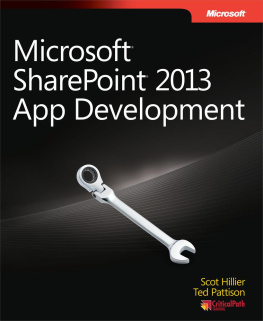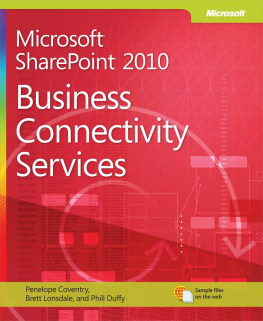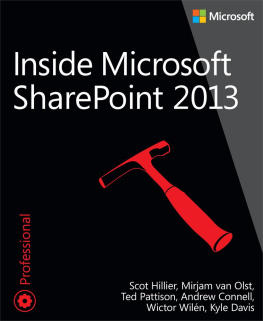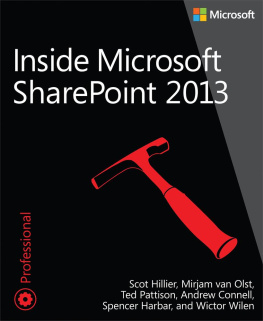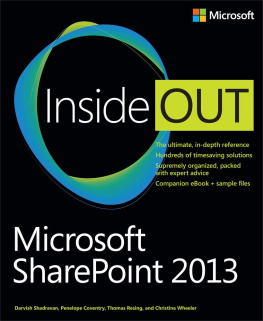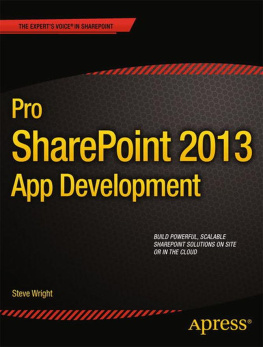Inside Microsoft SharePoint 2013
Scot Hillier
Mirjam van Olst
Ted Pattison
Andrew Connell
Wictor Wilen
Kyle Davis
Published by Microsoft Press
Special Upgrade Offer
If you purchased this ebook directly from oreilly.com, you have the following benefits:
DRM-free ebooksuse your ebooks across devices without restrictions or limitations
Multiple formatsuse on your laptop, tablet, or phone
Lifetime access, with free updates
Dropbox syncingyour files, anywhere
If you purchased this ebook from another retailer, you can upgrade your ebook to take advantage of all these benefits for just $4.99. to access your ebook upgrade.
Please note that upgrade offers are not available from sample content.
Introduction
The purpose of this book is to help you design and develop custom business apps and solutions for SharePoint 2013, which includes the two products SharePoint Foundation and SharePoint Server 2013. Our goal is to teach you how to create, debug, and deploy the various components of apps and solutions such as Features, Pages, App Parts, Remote Event Handlers, and Workflows. Once you apply yourself and become comfortable developing with these building blocks, theres no limit to the types of apps and solutions you can create on the SharePoint 2013 platform.
Who this book is for
This book is written for experienced SharePoint developers who are proficient with Microsoft Visual Studio 2012, the Microsoft .NET Framework 4, and who understand the fundamentals of the SharePoint object model. The code samples in this book are written in JavaScript and C# and are intended to represent the spectrum of possible solutions. The primary audience for the book is SharePoint architects and developers looking to master SharePoint 2013 development.
Organization of this book
This book is organized into 17 chapters:
, provides a strategic view of SharePoint development options. The chapter presents the various development models and how they fit into the overall SharePoint development story.
, provides guidance in setting up your development environment. Additionally, the chapter covers related technologies that are important for SharePoint development, such as Windows PowerShell.
, presents the fundamentals of sandbox and full-trust solution development. The chapter also presents the basics of the server-side object model.
, covers the new app model in detail. This chapter presents the tools and techniques necessary for developing apps.
, first provides a JavaScript and jQuery primer for SharePoint developers with an emphasis on professional patterns. The second half of the chapter presents the fundamentals of the client-side object model and REST APIs for SharePoint 2013.
, presents the security concepts necessary for successfully developing solutions and apps. This chapter explains the concepts behind user authentication and authorization, in addition to the app principal. This chapter also presents the details behind the claims and OAuth security models.
, presents techniques and information for working with pages in SharePoint solutions and apps. The chapter covers core concepts such as master pages, content placeholders, and application pages.
, presents the tools and techniques required to create Web Parts and app parts.
, presents the information necessary for creating lists and performing operations against them. This chapter contains many code samples for reading and writing, using both server and client technologies.
, covers the techniques for creating field types and field controls. The second part of the chapter covers the new JSLink technology and how it can be used to customize views.
, shows how to create site templates and site definitions. These templates can be reused in solutions and apps.
, presents all the information necessary for developing custom workflows by using the new Workflow Manager engine. Techniques for both the SharePoint Designer and Visual Studio are presented.
, presents architecture and development techniques for Enterprise Search. The chapter details the creation of no-code solutions as well as apps.
, presents structure and development techniques for managed metadata, document services, and records management.
, details the significant improvements made for supporting website development. The chapter presents improvements in data-driven sites, master page creation, and metadata navigation.
, provides the background and tools for creating solutions based on data in external systems. The chapter presents approaches for both solutions and apps.
, presents the details of the new social infrastructure. The chapter also shows how to create solutions that utilize social features.
Acknowledgments
The process of writing this book really began two years before the release of SharePoint 2013, when we were fortunate enough to be selected as the team to create the first SharePoint 2013 training materials for Microsoft. We worked through many Dev Kitchens with the SharePoint team and got great information from Mike Ammerlann, Rob Howard, Brad Stevenson, Mike Morton, Mauricio Ordonez, and many others. After learning the technologies, we worked with a great team headed by Keenan Newton to deliver training to Microsoft personnel around the country. Later, we worked with Uma Subramanian and the MSDN team to create samples and videos to be deployed online. Thanks to all these people and everyone at Microsoft for the wonderful support and opportunities.
Of course, the book could not possibly have come together without the patience and support of the team at Microsoft Press, starting with our editor, Ken Brown (OReilly Media). Although we frustrated him endlessly at times, he maintained focus and drove us all to success. Wed also like to thank Kara Ebrahim (Production Editor, OReilly Media), Kathy Krause (Copyeditor, Online Training Solutions, Inc. [OTSI]), Wayne Ewington (Technical Editor), and Neil Hodgkinson (Technical Editor).
Thanks, everyone. It feels great to be done!
Support & feedback
The following sections provide information on errata, book support, feedback, and contact information.
Errata
Weve made every effort to ensure the accuracy of this book and its companion content. Any errors that have been reported since this book was published are listed at:
http://aka.ms/InsideSP2013/errata
If you find an error that is not already listed, you can report it to us through the same page.
If you need additional support, email Microsoft Press Book Support at .
Please note that product support for Microsoft software is not offered through the addresses above.
We want to hear from you
At Microsoft Press, your satisfaction is our top priority, and your feedback our most valuable asset. Please tell us what you think of this book at:
http://aka.ms/tellpress
The survey is short, and we read every one of your comments and ideas. Thanks in advance for your input!
Stay in touch
Lets keep the conversation going! Were on Twitter: http://twitter.com/MicrosoftPress
Chapter 1. SharePoint 2013 developer roadmap
Microsoft SharePoint technologies have become increasing popular and have made it into the mainstream of IT infrastructures used by companies and organizations around the world. Today, millions of people work with SharePoint technologies every day, including business users, power users, executives, site administrators, farm administrators, and professional developers.


